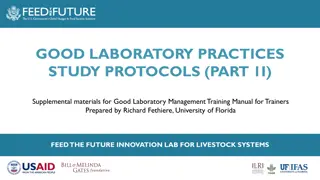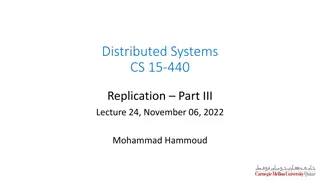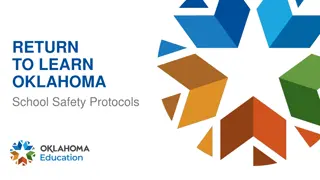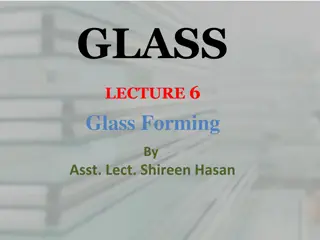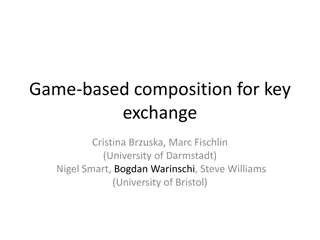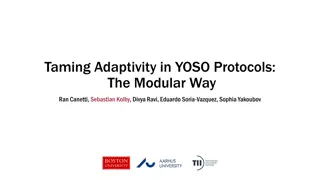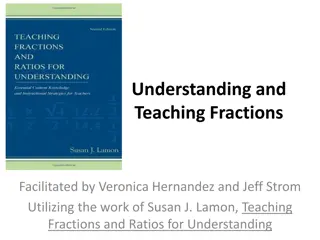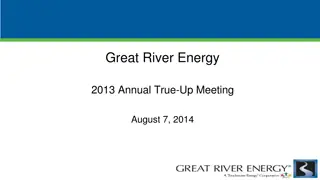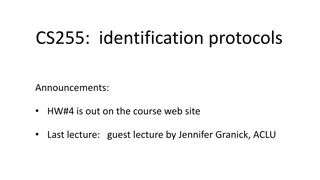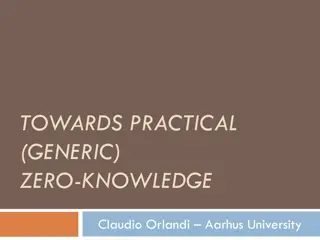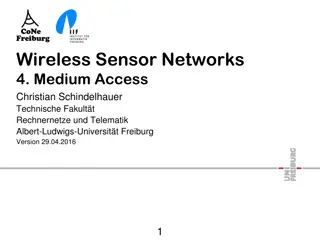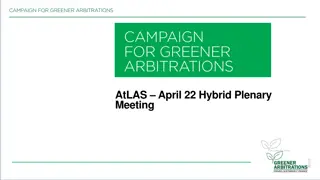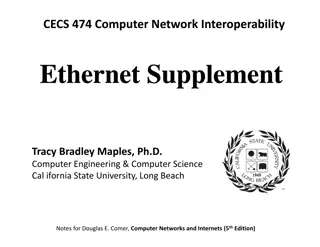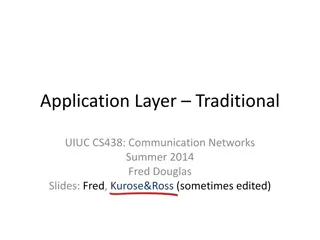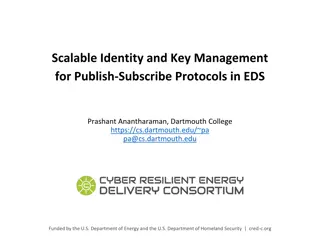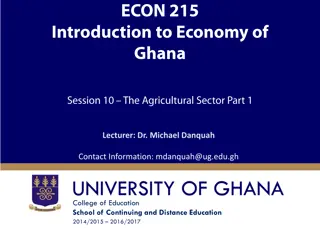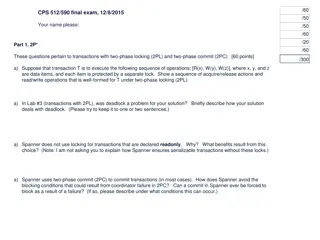Mechanized Model for CAN Protocols - FASE 2013
This research paper presents a mechanized model for Content Addressable Network (CAN) protocols, focusing on supporting RDF data storage in the Semantic Web. It discusses the general motivation, CAN principles, RDF queries, and challenges in handling queries over variables in large-scale settings. The study proposes solutions for enhancing routing performance, reducing query costs, and improving multicast services over structured P2P networks.
Download Presentation

Please find below an Image/Link to download the presentation.
The content on the website is provided AS IS for your information and personal use only. It may not be sold, licensed, or shared on other websites without obtaining consent from the author.If you encounter any issues during the download, it is possible that the publisher has removed the file from their server.
You are allowed to download the files provided on this website for personal or commercial use, subject to the condition that they are used lawfully. All files are the property of their respective owners.
The content on the website is provided AS IS for your information and personal use only. It may not be sold, licensed, or shared on other websites without obtaining consent from the author.
E N D
Presentation Transcript
A Mechanized Model for CAN Protocols Francesco Bongiovanni and Ludovic Henrio Context and objectives Our mechanized model Results Conclusions and Future Works
CONTEXT AND OBJECTIVES A Mechanised model for CAN - FASE 2013 2
General motivation: supporting RDF data storage RDF data is at the heart of the Semantic Web Supporting RDF means also supporting its query language Main challenge store and retrieve RDF data in large scale settings, that is, with a large number of geographically distributed participating nodes ? Our solution: Content Addressable Network (CAN) A Mechanised model for CAN - FASE 2013 3
CAN General principles Virtual Cartesian coordinate space of N dimensions Space partitioned amongst nodes every node owns a zone A node only knows its adjacent neighbours Stored Items mapped to points Routing performance: O(d.N1/d) CAN for RDF (our view): CAN [Ratnasamy et al. SIGCOMM 01] (x,y) No hashing easier to look for a range query One dimension per concern handling variables A Mechanised model for CAN - FASE 2013 4
RDF queries q= (s,p,o) q= (s,p,?o) q= (?s,?p,?o) q= (s,?p,?o) A Mechanised model for CAN - FASE 2013 5
Problem: cost of queries 2 queries over 2 variables: conjunction of two 2-dimensional broadcasts 1 query over 2 variables 1 query over 1 variable A Mechanised model for CAN - FASE 2013 6
Multicast Services over Structured P2P Networks 879 Duplicates: problem and existing solutions sponsible for the shadowed zone is the multicast data source Multicast Services over Structured P2P Networks Fig. 1 An example of the efficient flooding algorithm in a CAN-multicast system. The node re- 879 Fig. 2 An example of the enhanced efficient flooding algorithm in a CAN-multicast system. Note that now there are no double packets in any [Gupta et al. Middleware 2004] Fig. 1 An example of the efficient flooding algorithm in a CAN-multicast system. The node re- sponsible for the shadowed zone is the multicast data source Meghdoot: works only starting with corner inefficient with range M-CAN; claims: No duplicate in 2D Few duplicates in high dimensionsional CAN (<5%) Impossible to get rid of all duplicates in higher dimensions multicast: Members of a multicast group self-organize in an instance of Chord or DKS(N,k,f). Consequently, a multicast transmission to a certain group just requires to broadcast the Chord or DKS(N,k,f) instance associated to that group. However, this proposal differs from the CAN based multicast in the flooding mechanism. As it is explained in Section 2.1, the efficient flooding algorithm (and also its enhanced version) produces redundant messages. The Chord/DKS flooding algorithm that is called correcting broadcast eliminates any redundant packets. [Ratnasamy, et al. Networked Group Communication 2001] A Mechanised model for CAN - FASE 2013 7 Fig. 2 An example of the enhanced efficient flooding algorithm in a CAN-multicast system. Note that now there are no double packets in any multicast: Members of a multicast group self-organize in an instance of Chord or DKS(N,k,f). Consequently, a multicast transmission to a certain group just requires to broadcast the Chord or DKS(N,k,f) instance associated to that group. However, this proposal differs from the CAN based multicast in the flooding mechanism. As it is explained in Section 2.1, the efficient flooding algorithm (and also its enhanced version) produces redundant messages. The Chord/DKS flooding algorithm that is called correcting broadcast eliminates any redundant packets.
Evaluating the impact of duplicated messages Flooding M-CAN Our algorithm A Mechanised model for CAN - FASE 2013 8
Our objectives here Is there an optimal broadcast algorithm for CAN? Can we be sure? ! Here: optimal = no duplicate ! More generally, we think that providing mechanised formalisations of our systems: Increase the confidence in the system Help programmers implement correct (and efficient) systems HERE: a framework to reason on CAN networks, focusing on communications and broadcasts + a proof that there exists an optimal algorithm A Mechanised model for CAN - FASE 2013 9
A MECHANISED MODEL OF CAN A Mechanised model for CAN - FASE 2013 10
Defining a CAN: First attempt Definition 1: Constructive from the seminal paper Split alternating dimension When a node leaves, - The organisation can be maintained by keeping the split history (+data transfers) - or one neighbour takes two zones (no more rectangles?) - Alternative: change the reachable configurations Main drawback: difficult to define in a theorem prover What is the invariant verified by the CAN construction? A Mechanised model for CAN - FASE 2013 11
Defining a CAN: A more general version Definition 2: Each zone is a rectangle More freedom in the implementation easier to define in a theorem prover Rectangles are necessary to prove optimality of some broadcasts (eg. M-CAN in 2D) But no guarantee on the lookup time in general Churns: more flexible, but can one node manage two zones? A Mechanised model for CAN - FASE 2013 12
Our definition: the most general one Definition 3: each zone can have any shape A CAN is a finite set of nodes,Zones,neighbour such that The neighbour relation is symmetric Zones cover the whole space Each point belongs to a single zone Neighbouring is not related to the topology We abstracted away all reasoning on geometry Note: we can always add constraints to reach the other definitions HERE: no churn (but easier to encode) A Mechanised model for CAN - FASE 2013 13
The formal version (math vs. Isabelle) A Mechanised model for CAN - FASE 2013 14
BROADCAST AND PROOFS A Mechanised model for CAN - FASE 2013 15
Other definitions Connected zone: a zone in which communications is possible ! Zones are not necessarily associated to a node! Path = sequence of messages where each message is sent from the destination of the previous one Broadcast message: Source, dest, zone to be covered ZNL = Zone node list: Splits the zone yet to be covered Into several destinations and (connected) zones A ZNL is optimal if no node belong to two sub-zones A Mechanised model for CAN - FASE 2013 16
Defining broadcast - principles A broadcast is a function that takes an initiatorand a ZNLmap function (Node x Zone ZNL). Computes the set of messages resulting of the inductive application of the ZNLmap function Init Is it possible to define an optimal broadcast? What is the good ZNLmap function? Can it rely only on local information? A Mechanised model for CAN - FASE 2013 17
Naive optimal broadcast Idea: Only split when it is necessary = when the zone to be covered is disconnected Init A Mechanised model for CAN - FASE 2013 18
Overview of our framework P2P protocol CAN (reusable) abstractions Messages Zones Nodes Fine grain Properties + proofs Induction principles on zones Connected existing neighbors Finite messages Finite paths inside zone Finite zones ZNL properties Combining proofs Optimality Coverage Zone decomposition Distributed algorithm Existence of an optimal broadcast A Mechanised model for CAN - FASE 2013 - 19
Principle of the proofs Coverage: valid ZNL coverage Existence of an optimal BC: OptimalZNL Optimal broadcast ZNLmap such that each ZNL is an OptimalZNL (using the naive decomposition) Is it possible to define an optimal broadcast? YES What is the good ZNLmap function? The na ve decomposition Can it rely only on local information? A Mechanised model for CAN - FASE 2013 20
Locality arguments: Is it really a peer-to-peer solution? Prerequisite: only part of the ZNLmap is useful (history) The ZNLmap can be constructed step by step (proved) Proved step-by-step progress, building an optimal ZNL locally . Is it possible to define an optimal broadcast? YES What is the good ZNLmap function? The na ve decomposition . Can it rely only on local information? In our framework the knowledge of the whole CAN is only necessary to compute connectedness (no topology) A Mechanised model for CAN - FASE 2013 21
CONCLUSIONS AND FUTURE WORKS A Mechanised model for CAN - FASE 2013 22
Conclusions: Results Properties: The ZNL-approach is sufficient for addressing coverage There exists a way to construct a ZNL for optimal broadcast There exists a broadcast algorithm that produces no duplicate; it is only based on local decisions A Mechanised model for CAN - FASE 2013 23
Conclusion: Mechanisation A framework for reasoning on CAN: A possible definition of CAN (very generic) Basic abstractions, induction principle Constructs for reasoning on messages and broadcasts The only non-proved arguments are related to topology and geometry (locality of connectedness, and 1 axiom: the whole space is connected) Around 5000 lines of Isabelle/HOL www-sop.inria.fr/oasis/personnel/Ludovic.Henrio/misc A Mechanised model for CAN - FASE 2013 24
Current and future work We have a non-naive optimal algorithm! Close to M-CAN but no duplicate at all Experimented To be published and proven formally [Henrio, HDR 2012; Bongiovanni, PhD 2012] About churns (= nodes arriving and leaving frequently) Our definition of CAN is quite flexible But neighbours evolve at runtime TODO: improve the mechanised model, what is a good algorithm/good properties in presence of churns? (#duplicates #churns?) A Mechanised model for CAN - FASE 2013 25
THANK YOU francesco.bongiovanni@inria.fr Ludovic.henrio@cnrs.fr A Mechanised model for CAN - FASE 2013 26


